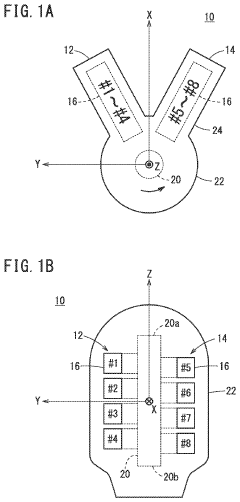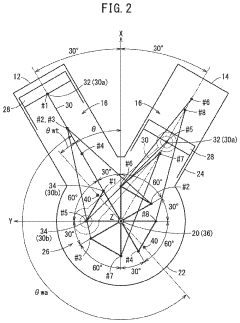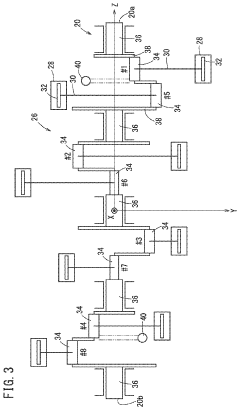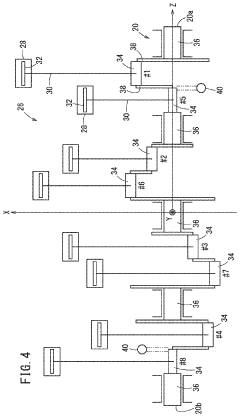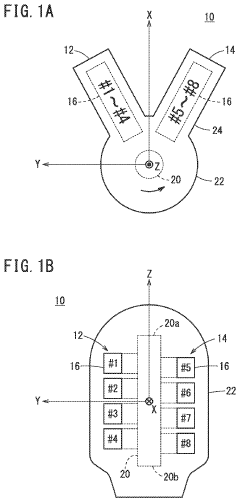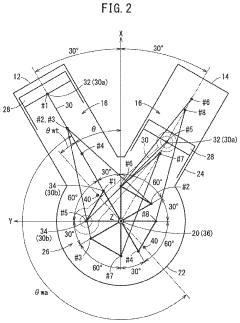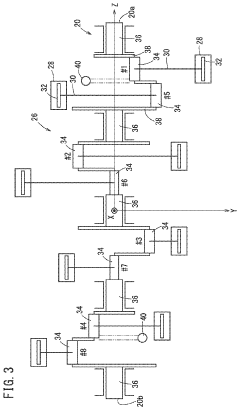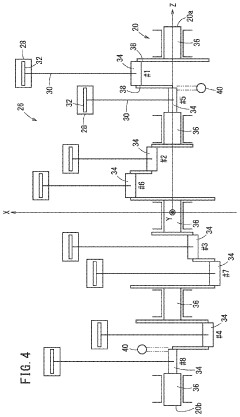How V8 Engines Propel Future Automotive Design Concepts?
JUL 4, 20259 MIN READ
Generate Your Research Report Instantly with AI Agent
Patsnap Eureka helps you evaluate technical feasibility & market potential.
V8 Engine Evolution
The V8 engine has undergone significant evolution since its inception, shaping the landscape of automotive design and performance. Initially developed in the early 20th century, V8 engines quickly became synonymous with power and prestige in the automotive world. The configuration, featuring two banks of four cylinders arranged in a V-shape, offered a compact design with impressive power output, making it ideal for high-performance vehicles and luxury cars.
Throughout the 1950s and 1960s, V8 engines reached their golden age, particularly in American muscle cars. This era saw rapid advancements in engine design, including the introduction of overhead valve (OHV) configurations and higher compression ratios, which significantly boosted power output and efficiency. The iconic Ford Flathead V8 and Chevrolet Small-Block V8 became benchmarks for performance and reliability during this period.
As environmental concerns grew in the 1970s, V8 engines faced challenges with stricter emission regulations and fuel economy standards. This led to a period of adaptation, where manufacturers focused on developing more efficient V8 designs. Technologies such as fuel injection, variable valve timing, and cylinder deactivation were introduced to improve fuel economy without sacrificing performance.
The 1990s and 2000s saw a resurgence of V8 engines in high-performance vehicles, thanks to advancements in materials science and computer-aided design. Lightweight alloys and precision manufacturing techniques allowed for higher revving, more powerful V8s that could meet stringent emissions standards. The introduction of forced induction, particularly turbocharging and supercharging, further enhanced V8 performance while improving efficiency.
In recent years, the evolution of V8 engines has been driven by the need for sustainability and electrification. Hybrid V8 powertrains have emerged, combining traditional internal combustion with electric motors to deliver exceptional performance with reduced emissions. Additionally, manufacturers have explored alternative fuels and advanced combustion techniques to make V8 engines more environmentally friendly.
Looking towards the future, V8 engines continue to evolve, with a focus on integrating cutting-edge technologies. Advanced materials, such as carbon fiber components and 3D-printed parts, are being incorporated to reduce weight and improve thermal efficiency. Furthermore, the development of smart engine management systems and artificial intelligence is enabling V8 engines to optimize performance and efficiency in real-time, adapting to driving conditions and user preferences.
Throughout the 1950s and 1960s, V8 engines reached their golden age, particularly in American muscle cars. This era saw rapid advancements in engine design, including the introduction of overhead valve (OHV) configurations and higher compression ratios, which significantly boosted power output and efficiency. The iconic Ford Flathead V8 and Chevrolet Small-Block V8 became benchmarks for performance and reliability during this period.
As environmental concerns grew in the 1970s, V8 engines faced challenges with stricter emission regulations and fuel economy standards. This led to a period of adaptation, where manufacturers focused on developing more efficient V8 designs. Technologies such as fuel injection, variable valve timing, and cylinder deactivation were introduced to improve fuel economy without sacrificing performance.
The 1990s and 2000s saw a resurgence of V8 engines in high-performance vehicles, thanks to advancements in materials science and computer-aided design. Lightweight alloys and precision manufacturing techniques allowed for higher revving, more powerful V8s that could meet stringent emissions standards. The introduction of forced induction, particularly turbocharging and supercharging, further enhanced V8 performance while improving efficiency.
In recent years, the evolution of V8 engines has been driven by the need for sustainability and electrification. Hybrid V8 powertrains have emerged, combining traditional internal combustion with electric motors to deliver exceptional performance with reduced emissions. Additionally, manufacturers have explored alternative fuels and advanced combustion techniques to make V8 engines more environmentally friendly.
Looking towards the future, V8 engines continue to evolve, with a focus on integrating cutting-edge technologies. Advanced materials, such as carbon fiber components and 3D-printed parts, are being incorporated to reduce weight and improve thermal efficiency. Furthermore, the development of smart engine management systems and artificial intelligence is enabling V8 engines to optimize performance and efficiency in real-time, adapting to driving conditions and user preferences.
Market Demand Analysis
The market demand for V8 engines in future automotive design concepts is undergoing significant shifts, driven by evolving consumer preferences, regulatory pressures, and technological advancements. Despite the global push towards electrification and downsizing, there remains a niche but passionate market segment that continues to value the performance, sound, and heritage associated with V8 engines.
In the luxury and high-performance vehicle sectors, V8 engines still command a premium position. These engines are often seen as a hallmark of prestige and power, particularly in markets such as the United States, Middle East, and parts of Europe. The distinctive rumble and acceleration characteristics of V8 engines continue to appeal to enthusiasts and collectors, maintaining a steady demand in specialized vehicle categories.
However, the overall market trend shows a gradual decline in V8 engine demand for mainstream vehicles. This shift is primarily due to increasing fuel efficiency standards and environmental regulations worldwide. Many automakers are phasing out V8 engines in favor of smaller, turbocharged engines or hybrid powertrains that offer comparable performance with improved fuel economy.
The sports car and performance vehicle segment presents a unique case. While some manufacturers are moving away from V8 engines, others are doubling down on their V8 offerings, recognizing the engine's role in brand identity and customer loyalty. These companies are investing in advanced technologies to make V8 engines more efficient and compliant with stricter emissions standards, thereby preserving their appeal in a changing market landscape.
In the truck and SUV market, particularly in North America, V8 engines continue to see strong demand. The towing capacity and durability associated with V8 engines make them a preferred choice for consumers who prioritize utility and power. However, even in this segment, there is growing competition from turbocharged V6 engines and emerging electric powertrains that promise equivalent or superior performance.
The aftermarket and customization industry also plays a significant role in sustaining demand for V8 engines. Enthusiasts and custom car builders continue to seek out V8 engines for their projects, contributing to a robust secondary market for these powerplants.
Looking ahead, the market for V8 engines in future automotive designs is likely to become more specialized and niche-oriented. While overall volumes may decrease, the engines that remain in production are expected to become more advanced, incorporating technologies such as cylinder deactivation, mild hybridization, and advanced materials to meet both performance expectations and regulatory requirements.
In the luxury and high-performance vehicle sectors, V8 engines still command a premium position. These engines are often seen as a hallmark of prestige and power, particularly in markets such as the United States, Middle East, and parts of Europe. The distinctive rumble and acceleration characteristics of V8 engines continue to appeal to enthusiasts and collectors, maintaining a steady demand in specialized vehicle categories.
However, the overall market trend shows a gradual decline in V8 engine demand for mainstream vehicles. This shift is primarily due to increasing fuel efficiency standards and environmental regulations worldwide. Many automakers are phasing out V8 engines in favor of smaller, turbocharged engines or hybrid powertrains that offer comparable performance with improved fuel economy.
The sports car and performance vehicle segment presents a unique case. While some manufacturers are moving away from V8 engines, others are doubling down on their V8 offerings, recognizing the engine's role in brand identity and customer loyalty. These companies are investing in advanced technologies to make V8 engines more efficient and compliant with stricter emissions standards, thereby preserving their appeal in a changing market landscape.
In the truck and SUV market, particularly in North America, V8 engines continue to see strong demand. The towing capacity and durability associated with V8 engines make them a preferred choice for consumers who prioritize utility and power. However, even in this segment, there is growing competition from turbocharged V6 engines and emerging electric powertrains that promise equivalent or superior performance.
The aftermarket and customization industry also plays a significant role in sustaining demand for V8 engines. Enthusiasts and custom car builders continue to seek out V8 engines for their projects, contributing to a robust secondary market for these powerplants.
Looking ahead, the market for V8 engines in future automotive designs is likely to become more specialized and niche-oriented. While overall volumes may decrease, the engines that remain in production are expected to become more advanced, incorporating technologies such as cylinder deactivation, mild hybridization, and advanced materials to meet both performance expectations and regulatory requirements.
Technical Challenges
The development of V8 engines for future automotive design concepts faces several significant technical challenges. One of the primary obstacles is the need to balance power output with fuel efficiency. As environmental concerns grow, automotive manufacturers must find ways to maintain the high performance associated with V8 engines while simultaneously reducing fuel consumption and emissions.
Another major challenge lies in the integration of advanced materials and manufacturing techniques. To achieve weight reduction without compromising structural integrity, engineers are exploring the use of lightweight alloys and composite materials. However, these materials often require specialized manufacturing processes and can be more expensive, potentially impacting production costs and scalability.
The electrification trend in the automotive industry presents a unique challenge for V8 engine development. As hybrid and electric powertrains gain popularity, designers must find innovative ways to incorporate electric motors and battery systems into V8-powered vehicles. This integration requires careful consideration of weight distribution, packaging, and thermal management to maintain the characteristic performance and driving experience of V8 engines.
Noise, vibration, and harshness (NVH) control is another critical area of focus. V8 engines are known for their distinctive sound, but stricter noise regulations and consumer preferences for quieter vehicles necessitate advanced sound engineering. Developing active noise cancellation systems and refining engine mounts to reduce vibrations while preserving the engine's character is a complex technical challenge.
The pursuit of higher thermal efficiency remains an ongoing challenge for V8 engine development. Engineers are exploring advanced combustion strategies, such as variable compression ratios and cylinder deactivation, to extract more power from each drop of fuel. However, implementing these technologies while maintaining reliability and drivability across a wide range of operating conditions requires sophisticated control systems and extensive testing.
Lastly, the challenge of meeting increasingly stringent emissions regulations cannot be overstated. Developing advanced aftertreatment systems, improving catalytic converter efficiency, and reducing cold-start emissions are critical areas of focus. Engineers must also contend with the complexities of real-world driving conditions and the need for engines to perform optimally across diverse global markets with varying fuel qualities and environmental regulations.
Another major challenge lies in the integration of advanced materials and manufacturing techniques. To achieve weight reduction without compromising structural integrity, engineers are exploring the use of lightweight alloys and composite materials. However, these materials often require specialized manufacturing processes and can be more expensive, potentially impacting production costs and scalability.
The electrification trend in the automotive industry presents a unique challenge for V8 engine development. As hybrid and electric powertrains gain popularity, designers must find innovative ways to incorporate electric motors and battery systems into V8-powered vehicles. This integration requires careful consideration of weight distribution, packaging, and thermal management to maintain the characteristic performance and driving experience of V8 engines.
Noise, vibration, and harshness (NVH) control is another critical area of focus. V8 engines are known for their distinctive sound, but stricter noise regulations and consumer preferences for quieter vehicles necessitate advanced sound engineering. Developing active noise cancellation systems and refining engine mounts to reduce vibrations while preserving the engine's character is a complex technical challenge.
The pursuit of higher thermal efficiency remains an ongoing challenge for V8 engine development. Engineers are exploring advanced combustion strategies, such as variable compression ratios and cylinder deactivation, to extract more power from each drop of fuel. However, implementing these technologies while maintaining reliability and drivability across a wide range of operating conditions requires sophisticated control systems and extensive testing.
Lastly, the challenge of meeting increasingly stringent emissions regulations cannot be overstated. Developing advanced aftertreatment systems, improving catalytic converter efficiency, and reducing cold-start emissions are critical areas of focus. Engineers must also contend with the complexities of real-world driving conditions and the need for engines to perform optimally across diverse global markets with varying fuel qualities and environmental regulations.
Current V8 Solutions
01 V8 Engine Design and Configuration
V8 engines are designed with eight cylinders arranged in two banks of four, forming a V-shape. This configuration allows for compact packaging, improved balance, and higher power output compared to inline engines. Various design aspects, such as cylinder angle, firing order, and crankshaft configuration, are optimized for performance and efficiency.- V8 Engine Design and Configuration: V8 engines are designed with eight cylinders arranged in two banks of four, forming a V-shape. This configuration allows for a compact design, improved power output, and balanced operation. Various aspects of V8 engine design, including cylinder arrangement, crankshaft configuration, and valve train systems, are continuously improved to enhance performance and efficiency.
- Fuel Injection and Combustion Systems: Advanced fuel injection and combustion systems are crucial for optimizing V8 engine performance. These systems include direct injection, variable valve timing, and cylinder deactivation technologies. Innovations in this area focus on improving fuel efficiency, reducing emissions, and enhancing power output across different operating conditions.
- Turbocharging and Supercharging: Forced induction systems, such as turbochargers and superchargers, are frequently used in V8 engines to boost power output and efficiency. These systems compress the intake air, allowing more fuel to be burned and increasing engine performance. Recent developments focus on reducing turbo lag, improving boost control, and integrating electric assistance for enhanced responsiveness.
- Engine Management and Control Systems: Sophisticated engine management and control systems are essential for optimizing V8 engine performance. These systems monitor and adjust various parameters such as fuel injection timing, ignition timing, and valve timing in real-time. Advanced control algorithms and sensors are employed to maximize efficiency, reduce emissions, and enhance drivability across different operating conditions.
- Materials and Manufacturing Techniques: Innovative materials and manufacturing techniques are employed in V8 engine production to reduce weight, improve durability, and enhance thermal efficiency. This includes the use of lightweight alloys, advanced coatings, and precision manufacturing processes. New materials and techniques are continuously developed to address challenges such as heat management, friction reduction, and structural integrity.
02 Fuel Injection Systems for V8 Engines
Advanced fuel injection systems are developed for V8 engines to improve fuel efficiency and performance. These systems may include direct injection, multi-port injection, or a combination of both. Precise fuel delivery and atomization are crucial for optimizing combustion and reducing emissions in high-performance V8 engines.Expand Specific Solutions03 Valve Train and Camshaft Innovations
Innovations in valve train components and camshaft designs enhance V8 engine performance. Variable valve timing, lift control systems, and advanced camshaft profiles are implemented to improve power output, fuel efficiency, and emissions across a wide range of operating conditions.Expand Specific Solutions04 Turbocharging and Supercharging V8 Engines
Forced induction systems, such as turbochargers and superchargers, are applied to V8 engines to increase power output and efficiency. These systems compress the intake air, allowing for more fuel to be burned and resulting in higher power density. Advanced control strategies and intercooling techniques are employed to optimize performance and reliability.Expand Specific Solutions05 Cooling and Lubrication Systems for V8 Engines
Specialized cooling and lubrication systems are developed for V8 engines to manage heat and reduce friction. These may include advanced coolant flow designs, oil cooling systems, and high-performance lubricants. Efficient thermal management and lubrication are critical for maintaining engine performance and longevity, especially in high-output V8 applications.Expand Specific Solutions
Key Industry Players
The V8 engine technology landscape is characterized by intense competition among established automotive giants and emerging players in a mature market. The industry is in a transitional phase, balancing traditional combustion engine refinement with the shift towards electrification. Major players like GM, Ford, Toyota, and Volkswagen are investing heavily in V8 engine innovations to enhance performance and efficiency. Simultaneously, luxury brands such as BMW, Porsche, and Mercedes-Benz continue to leverage V8 engines in high-end vehicles. The market size remains substantial, driven by demand in sports cars, luxury vehicles, and high-performance applications. However, the technology's maturity level is high, with incremental improvements rather than revolutionary changes being the norm. Emerging companies like Leapmotor are exploring ways to integrate V8 concepts into electric powertrains, signaling potential future directions for this iconic engine configuration.
GM Global Technology Operations LLC
Technical Solution: GM's V8 engine development is centered around their Small Block V8 architecture, which has been continually refined over decades. Recent innovations include Dynamic Fuel Management, allowing the engine to operate on anything from two to eight cylinders depending on demand[5]. GM has also introduced advanced materials in their V8 engines, such as carbon fiber intake manifolds, to reduce weight and improve performance. Their latest V8 designs incorporate direct injection, variable valve timing, and active fuel management systems. GM is also exploring the integration of mild hybrid systems with their V8 engines to meet stricter emissions standards while maintaining performance[6].
Strengths: Long-standing expertise in V8 design, advanced cylinder deactivation technology, and integration of lightweight materials. Weaknesses: Reliance on traditional V8 architecture may limit radical innovations, and the complexity of cylinder deactivation systems could impact reliability.
Bayerische Motoren Werke AG
Technical Solution: BMW's approach to V8 engine development focuses on high-performance applications while addressing efficiency concerns. Their latest V8 engines feature twin-turbocharging with electric assist, known as e-boost, which reduces turbo lag and improves overall engine response[7]. BMW has also implemented a cross-bank exhaust manifold, improving exhaust gas flow and turbocharger efficiency. Their V8 engines incorporate Valvetronic variable valve lift and Double-VANOS variable camshaft timing for optimized performance across the rev range. BMW is exploring the use of hydrogen fuel in their V8 engines as a potential pathway to reduce emissions while maintaining the characteristic V8 sound and performance[8].
Strengths: Advanced turbocharging technology, innovative exhaust design, and exploration of hydrogen fuel. Weaknesses: High complexity of systems may lead to increased production costs, and the focus on performance may result in higher fuel consumption compared to competitors.
Core V8 Innovations
V8 engine
PatentActiveUS11821359B2
Innovation
- The V8 engine configuration features crank pins arranged at 90° intervals on one bank and offset by 60° on the other bank, allowing for cancellation of primary inertia couples without additional specialized parts by optimizing the arrangement of crank pins and connecting rods.
V8 engine
PatentActiveUS20230109196A1
Innovation
- The V8 engine configuration features crank pins arranged at 90° intervals on one bank and offset by 60° on the other bank, allowing for cancellation of primary inertia couples without additional specialized components by optimizing the arrangement of crank pins and connecting rods.
Emissions Regulations
Emissions regulations play a crucial role in shaping the future of V8 engine design and automotive concepts. As governments worldwide implement increasingly stringent emissions standards, automakers are compelled to innovate and adapt their V8 engines to meet these requirements while maintaining performance and efficiency.
The evolution of emissions regulations has been a driving force behind technological advancements in V8 engine design. In recent years, many countries have adopted more stringent standards, such as Euro 6 in Europe and Tier 3 in the United States. These regulations set limits on various pollutants, including carbon dioxide (CO2), nitrogen oxides (NOx), and particulate matter (PM).
To comply with these regulations, automotive manufacturers have implemented various technologies in V8 engines. One key approach is the use of advanced fuel injection systems, such as direct injection, which allows for more precise control of fuel delivery and combustion. This technology helps reduce emissions while improving fuel efficiency and power output.
Another significant development is the widespread adoption of turbocharging in V8 engines. Turbochargers enable manufacturers to downsize engines without sacrificing performance, resulting in reduced fuel consumption and lower emissions. Many modern V8 engines now feature twin-turbo configurations, further enhancing their efficiency and power delivery.
Cylinder deactivation technology has also become increasingly common in V8 engines. This system allows the engine to shut down a portion of its cylinders during light-load conditions, effectively reducing fuel consumption and emissions without compromising performance when full power is needed.
The integration of start-stop systems in V8-powered vehicles has further contributed to emissions reduction. These systems automatically shut off the engine when the vehicle is stationary, such as at traffic lights, and restart it when the driver releases the brake pedal. This technology helps minimize unnecessary idling and reduces overall emissions, particularly in urban environments.
As emissions regulations continue to tighten, manufacturers are exploring more advanced technologies for V8 engines. Mild hybrid systems, which incorporate a small electric motor to assist the engine, are becoming increasingly prevalent. These systems can provide additional power during acceleration and enable more efficient engine operation, further reducing emissions and fuel consumption.
Looking ahead, the future of V8 engines in the context of emissions regulations may involve the development of more sophisticated exhaust aftertreatment systems. Advanced catalytic converters, particulate filters, and selective catalytic reduction (SCR) systems are likely to play a more significant role in ensuring V8 engines meet future emissions standards.
In conclusion, emissions regulations have been and will continue to be a driving force in the evolution of V8 engine design. As automakers strive to meet increasingly stringent standards, we can expect to see further innovations in fuel injection, turbocharging, hybridization, and exhaust aftertreatment technologies. These advancements will shape the future of automotive design concepts, ensuring that V8 engines remain viable and compliant in an era of heightened environmental awareness.
The evolution of emissions regulations has been a driving force behind technological advancements in V8 engine design. In recent years, many countries have adopted more stringent standards, such as Euro 6 in Europe and Tier 3 in the United States. These regulations set limits on various pollutants, including carbon dioxide (CO2), nitrogen oxides (NOx), and particulate matter (PM).
To comply with these regulations, automotive manufacturers have implemented various technologies in V8 engines. One key approach is the use of advanced fuel injection systems, such as direct injection, which allows for more precise control of fuel delivery and combustion. This technology helps reduce emissions while improving fuel efficiency and power output.
Another significant development is the widespread adoption of turbocharging in V8 engines. Turbochargers enable manufacturers to downsize engines without sacrificing performance, resulting in reduced fuel consumption and lower emissions. Many modern V8 engines now feature twin-turbo configurations, further enhancing their efficiency and power delivery.
Cylinder deactivation technology has also become increasingly common in V8 engines. This system allows the engine to shut down a portion of its cylinders during light-load conditions, effectively reducing fuel consumption and emissions without compromising performance when full power is needed.
The integration of start-stop systems in V8-powered vehicles has further contributed to emissions reduction. These systems automatically shut off the engine when the vehicle is stationary, such as at traffic lights, and restart it when the driver releases the brake pedal. This technology helps minimize unnecessary idling and reduces overall emissions, particularly in urban environments.
As emissions regulations continue to tighten, manufacturers are exploring more advanced technologies for V8 engines. Mild hybrid systems, which incorporate a small electric motor to assist the engine, are becoming increasingly prevalent. These systems can provide additional power during acceleration and enable more efficient engine operation, further reducing emissions and fuel consumption.
Looking ahead, the future of V8 engines in the context of emissions regulations may involve the development of more sophisticated exhaust aftertreatment systems. Advanced catalytic converters, particulate filters, and selective catalytic reduction (SCR) systems are likely to play a more significant role in ensuring V8 engines meet future emissions standards.
In conclusion, emissions regulations have been and will continue to be a driving force in the evolution of V8 engine design. As automakers strive to meet increasingly stringent standards, we can expect to see further innovations in fuel injection, turbocharging, hybridization, and exhaust aftertreatment technologies. These advancements will shape the future of automotive design concepts, ensuring that V8 engines remain viable and compliant in an era of heightened environmental awareness.
Performance Metrics
V8 engines have long been synonymous with high performance in the automotive industry, and their impact on future automotive design concepts remains significant. When evaluating the performance metrics of V8 engines in the context of future automotive design, several key factors come into play.
Power output is a crucial metric for V8 engines, typically measured in horsepower and torque. Modern V8 engines can produce upwards of 600 horsepower in production vehicles, with some high-performance variants exceeding 1,000 horsepower. This raw power translates to impressive acceleration and top speed capabilities, which continue to be desirable attributes in performance-oriented vehicles.
Fuel efficiency, once a weakness of V8 engines, has seen remarkable improvements through technologies such as direct injection, variable valve timing, and cylinder deactivation. These advancements have allowed V8 engines to achieve fuel economy figures that were previously unattainable, with some models reaching over 25 mpg in highway driving conditions.
Emissions performance is another critical metric, especially as environmental regulations become increasingly stringent. Modern V8 engines employ sophisticated exhaust after-treatment systems, including catalytic converters and particulate filters, to minimize harmful emissions. Some manufacturers have also integrated mild hybrid systems to further reduce emissions and improve fuel economy.
Durability and reliability are essential performance metrics for V8 engines, particularly in high-stress applications. Advanced materials and manufacturing techniques have enhanced the longevity of V8 engines, with many modern units capable of operating for hundreds of thousands of miles with proper maintenance.
Power-to-weight ratio is a key consideration in automotive design, and V8 engines continue to offer excellent performance in this regard. The compact design of V8 engines, coupled with lightweight materials such as aluminum alloys, allows for favorable power density, contributing to overall vehicle dynamics and handling characteristics.
Noise, vibration, and harshness (NVH) characteristics are important performance metrics that influence the driving experience. V8 engines are known for their distinctive sound, which many enthusiasts appreciate. However, advancements in engine mounts, sound insulation, and active noise cancellation technologies have allowed designers to fine-tune the NVH profile to suit different vehicle types and target markets.
Thermal efficiency is a critical metric that measures how effectively an engine converts fuel energy into mechanical work. Modern V8 engines have achieved thermal efficiencies approaching 40%, a significant improvement over earlier generations. This increased efficiency translates to better fuel economy and reduced emissions, aligning with future automotive design goals.
As automotive design concepts evolve, the performance metrics of V8 engines continue to adapt. The integration of electrification, such as in hybrid powertrains, is expanding the performance envelope of V8 engines while addressing efficiency and emissions concerns. This synergy between traditional V8 power and cutting-edge electric technology is shaping the future of high-performance automotive design.
Power output is a crucial metric for V8 engines, typically measured in horsepower and torque. Modern V8 engines can produce upwards of 600 horsepower in production vehicles, with some high-performance variants exceeding 1,000 horsepower. This raw power translates to impressive acceleration and top speed capabilities, which continue to be desirable attributes in performance-oriented vehicles.
Fuel efficiency, once a weakness of V8 engines, has seen remarkable improvements through technologies such as direct injection, variable valve timing, and cylinder deactivation. These advancements have allowed V8 engines to achieve fuel economy figures that were previously unattainable, with some models reaching over 25 mpg in highway driving conditions.
Emissions performance is another critical metric, especially as environmental regulations become increasingly stringent. Modern V8 engines employ sophisticated exhaust after-treatment systems, including catalytic converters and particulate filters, to minimize harmful emissions. Some manufacturers have also integrated mild hybrid systems to further reduce emissions and improve fuel economy.
Durability and reliability are essential performance metrics for V8 engines, particularly in high-stress applications. Advanced materials and manufacturing techniques have enhanced the longevity of V8 engines, with many modern units capable of operating for hundreds of thousands of miles with proper maintenance.
Power-to-weight ratio is a key consideration in automotive design, and V8 engines continue to offer excellent performance in this regard. The compact design of V8 engines, coupled with lightweight materials such as aluminum alloys, allows for favorable power density, contributing to overall vehicle dynamics and handling characteristics.
Noise, vibration, and harshness (NVH) characteristics are important performance metrics that influence the driving experience. V8 engines are known for their distinctive sound, which many enthusiasts appreciate. However, advancements in engine mounts, sound insulation, and active noise cancellation technologies have allowed designers to fine-tune the NVH profile to suit different vehicle types and target markets.
Thermal efficiency is a critical metric that measures how effectively an engine converts fuel energy into mechanical work. Modern V8 engines have achieved thermal efficiencies approaching 40%, a significant improvement over earlier generations. This increased efficiency translates to better fuel economy and reduced emissions, aligning with future automotive design goals.
As automotive design concepts evolve, the performance metrics of V8 engines continue to adapt. The integration of electrification, such as in hybrid powertrains, is expanding the performance envelope of V8 engines while addressing efficiency and emissions concerns. This synergy between traditional V8 power and cutting-edge electric technology is shaping the future of high-performance automotive design.
Unlock deeper insights with Patsnap Eureka Quick Research — get a full tech report to explore trends and direct your research. Try now!
Generate Your Research Report Instantly with AI Agent
Supercharge your innovation with Patsnap Eureka AI Agent Platform!
